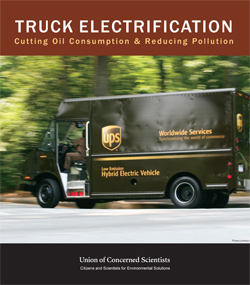$1.5 billion in a single day. That’s the estimated value of internet purchases made on Cyber Monday this year, up 17 percent from last year and the current record. Most of those purchases, ranging from iPads to Furby’s, will have traveled thousands of miles by ship, train, or truck before making the final leg of their trip in a local delivery truck. Of course, internet shopping prompts the question: Is getting the package delivered to your house better or worse for the environment than picking it up at the store?
 A 2009 study by Carnegie Mellon, covered in this LA Times blog, concluded that the environmental impact of online shopping is less than traditional shopping — basically finding that a truck delivering many packages on a delivery route produces less emissions than lots of individual car trips to and from local retailers.
A 2009 study by Carnegie Mellon, covered in this LA Times blog, concluded that the environmental impact of online shopping is less than traditional shopping — basically finding that a truck delivering many packages on a delivery route produces less emissions than lots of individual car trips to and from local retailers.
But just as taking fewer trips to the store or using alternative transportation options like public transit or biking can lower the footprint of traditional shopping, so too can the impact of online shopping be reduced. One way is by using cleaner, more efficient delivery trucks.
Our recent review of electrification options for trucks shows that urban delivery vehicles, like those Fedex and UPS trucks delivering your holiday packages, have the potential further reduce their emissions and oil consumption with the use of hybrid and battery electric technologies.
Urban delivery trucks travel short, defined routes with lots of stop-and-go operation and are often parked at a central location when not in use. These attributes make them good candidates for hybridization as well as full electrification.
Stop-and-go driving provides more opportunities to capture some of the energy usually lost when stopping a vehicle. Both hybrids and full electric vehicles can store this energy in on-board batteries for later use, a technology known as regenerative braking. This also helps reduce wear on the trucks brakes, resulting in savings on brake replacement costs.
With well established routes, delivery fleets know precisely how far a vehicle needs to travel during a shift and how long the vehicle is parked between shifts. A full battery electric truck with sufficient range and recharge time then becomes an option for fleets to consider. Hybrid delivery trucks can reduce gasoline or diesel consumption 25 to 35 percent , while fully electric trucks can eliminate it.
Hybrid heavy-duty trucks
Hybrid-electric powertrains are the most mature electric-drive truck technology presently on the road. Several truck manufacturers are now offering hybrid models, and thousands of hybrid systems are being used in applications ranging from public-transit and school buses to package- and beverage-delivery trucks. Prices for hybrid trucks are still a barrier for widespread adoption, but incentive programs like this one in California are helping grow the early market.
As the technology matures and manufacturing volumes increase, hybrid trucks will become a viable choice for more delivery fleets, which will reap the benefits of lower fuel costs and protection against fuel price volatility. Some of the nation’s largest parcel-delivery fleets, including FedEx and UPS, currently employ this technology. For example, FedEx currently operates 330 hybrid-electric vehicles in the United States.
Battery electric trucks
Fully electric trucks are a more recent available option and are seeing interest from delivery fleets and municipalities. The range of a present-day battery electric truck varies, depending on the load it carries and the capacity of its batteries, from about 50 to 100 miles per charge. Companies such as AT&T, Coca-Cola, Frito-Lay, and Staples have added electric delivery trucks to their fleets. Municipalities, including Chicago and New York City, are also taking an interest in electric trucks as well, seeing an opportunity to be leaders in adopting clean transportation technology, tackling urban air pollution, and creating local jobs.
Today, spotting an all-electric delivery truck bringing holiday presents to your door may be as rare a real-life Santa sighting, but that could change in the years to come with continued support from fleet managers, manufacturers, and policy makers alike.
Just as with passenger cars there’s no one size fits all solution to reducing emissions and oil consumption from trucks. But with continued investments in truck electrification, truck owners will gain more opportunities to save money on fuel costs and reduce emissions while helping to cut our projected oil consumption in half in 20 years.
And why should we cut our oil consumption in half?
Remember that $1.5 billion spent in a single day of internet shopping? Still doesn’t beat the estimated $1.9 billion American’s spent on gasoline and diesel that day.
Learn more about electric vehicles. Recent posts from the Equation:
